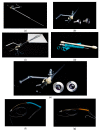Laparogastroscopy-A Transgastric Laparoscopic Approach for Malignant Esophageal Stenosis
- PMID: 36981472
- PMCID: PMC10048741
- DOI: 10.3390/healthcare11060815
Laparogastroscopy-A Transgastric Laparoscopic Approach for Malignant Esophageal Stenosis
Abstract
This paper presents the laparogastroscopy procedure, a mini-invasive, palliative method as an alternative to gastrostomy to be recommended by gastroenterologists. Laparogastroscopic stenting with endoluminal transtumoral drilling solves the problem of oral nutrition in patients with unresectable esophageal cancer, avoiding percutaneous feeding. The results of this technique are presented in a retrospective analysis of a study group of 63 patients with advanced esophageal carcinoma admitted between January 2015 and December 2020 at Department of General Surgery of Emergency County Hospital Sibiu, Romania, in terms of post-operative morbidity and mortality. The type of stents used were Pezzer prostheses (48.6%), silicone prostheses (31.9%), and self-expanding metal stents (6.9%). Eight patients (12.7%) had fistulas (at admission to the clinic), which were successfully sealed. Post-operative dysphagia was absent in most patients and minimal in 16.6% of patients, so all patients could initiate oral feeding, improving their nutritional status. The average length of hospitalization for all patients was 9.22 ± 5.05 days. The most frequent local complications were restenosis (9.5%), stent displacement (7.9%), and bleeding (4.8%). The mean survival time was 10.75 ± 15.72 months. Laparogastroscopic stenting could be a valuable alternative in palliative esophageal cancer surgery, improving the quality of life and nutritional status in patients unsuitable for endoscopic stenting.
Keywords: cancer; esophageal; laparogastroscopy; palliation; surgery.
Conflict of interest statement
The authors declare no conflict of interest.
Figures





References
-
- Janmaat V.T., Steyerberg E.W., van der Gaast A., Mathijssen R.H., Bruno M.J., Peppelenbosch M.P., Kuipers E.J., Spaander M.C.W. Cochrane Database of Systematic Reviews. John Wiley & Sons, Ltd.; Hoboken, NJ, USA: 2017. Palliative chemotherapy and targeted therapies for esophageal and gastroesophageal junction cancer; p. 11. - PMC - PubMed
LinkOut - more resources
Full Text Sources

